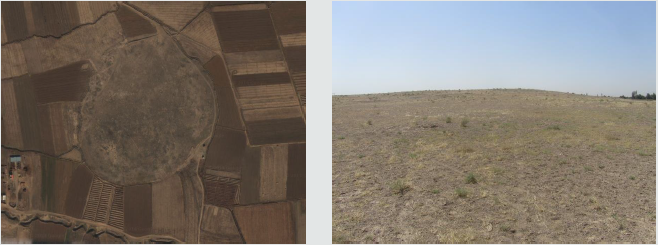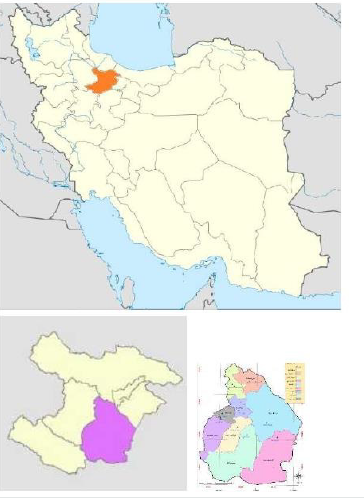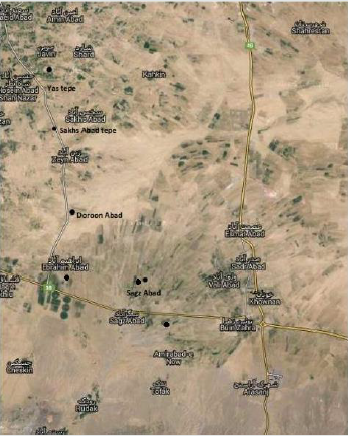
Lupine Publishers Group
Lupine Publishers
Menu
ISSN: 2690-5752
Review Article(ISSN: 2690-5752) 
Identifying the Newfound Sites in the Southern District of the Qazvin Plain, and Its Implications for Understanding How the Region Transformed in the Iron Age Volume 2 - Issue 5
Hossein Tahan*
- Science and Research Branch (SRBIAU), The Islamic Azad University, Iran
Received: August 26, 2020 Published: September 10, 2020
Corresponding author: Hossein Tahan, Archeology PhD, and Qazvin cultural heritage expert, Science and Research Branch (SRBIAU), The Islamic Azad University, Iran
DOI: 10.32474/JAAS.2020.02.000146
Abstract
The Qazvin Plain, located in the Central Iranian Plateau, is ripe with historical artifacts, and significant investigations and excavations have been conducted there. Those efforts are notable for revealing pre-historic sites with cultural continuity, dispersed across the southern district of the Qazvin Plain and dating back from the Paleolithic Period to the Historic Period. However, some questions and ambiguities regarding the Iron Age sites still remained that led me to explore the region. The results of this investigation include identifying and introducing several sites from the Iron Age and the transitional era to the Historic Period, which shows that there are far more Iron Age sites in the region. Moreover, the identification of vast sites in that region suggests that centers of culture may have moved in the Iron Age. It also implies that as the Iron Age transitioned into the Historic Period and governments formed in the Central Iranian Plateau, the ways of communication between the settlements changed, and the communities expanded along a straight line and became of importance.
Keywords:Qazvin Plain; Bronze Age; Iron Age; Settlement Pattern
Introduction
The southern district of the Qazvin Plain, constituting the Buin
Zahra County, stretches naturally along the Qazvin Plain, which is
located in the southern part of the Qazvin Province and covers an
area of 2323 sq. km, equal to 14.76% of the province area (Figure
1).
The first series of archeological investigations and excavations
in Buin Zahra, specifically Sagz Abad, were conducted by Belgian
and Japanese teams in the late 1960s [1]. Later, in 1968, Amir
Mahani, the then-president of the Qazvin Department of Culture and
Art, made some archeological speculations regarding Teppe Sagz
Abad [2]. This was followed by a series of regular investigations
by University of Tehran from August 1950 to 1979. After years
of hiatus, the excavations were resumed and continue to this day
(2016).
The periodical discovery of artifacts in the Sagz Abad site and
the surrounding sites, along with the related reports, brought
more attention to the region and led to further investigations
and excavations in the nearby areas, which, in turn, distinguished
different pre-historic ages there. Those efforts generated several
reports and articles, including: An investigation of the Mohammad
Abad site, by Houshang Sobouti [3]; Archeological investigations
of the Qazvin Plain, by Hassan Fazeli Nashli [4]; Archeological
investigations of Buin Zahra and Avaj [5]; An investigation of the
ancient sites on the mountains of the southern Qazvin Plain (Buin
Zahra) [6]; Gradual evolution of economic life in the Qazvin Plain
[7]; Metallurgy technologies of the Bronze and Iron Ages in Teppe
Sagz Abad [8]; Determining how metal objects were made in the
Iron Age [9]; Radiocarbon dating of the Iron Age Sagz Abad, by
Pollard and colleagues [10]; Excavations in and speculations about Teppe Sagz Abad, by Niknami [11, 12]. However, despite the existing
reports, some ambiguities regarding the settlements in the Bronze
and Iron Ages and also regional transformations still persisted,
which called for a revisiting and further investigation of the region.
In order to do so, I took into consideration the existing findings and data, and revisited the region. In addition to revisiting the previously-discovered Iron Age sites, I identified several more. This investigation yielded interesting results.
Identifying and introducing newfound Iron Age sites
The investigation in the southern district of the Qazvin Plain
(Buin Zahra County) identified 7 Iron Age sites, some of which were
previously introduced and some, including the sites Sakhs Abad
and Joharin, were identified and introduced for the first time [13].
The Teppe Sakhs Abad site contains earthenware dating back
to the Iron Age phases 1-3 (1500-330 BC), suggesting that it was
a residential area during the aforementioned time span. Also, the
Yas Teppe Joharin site, constituting the northernmost of the Iron
Age settlement sites in the region, exhibits earthenware from
the Bronze, Iron, and Historic Ages, and seems to be the largest
settlement site in Buin Zahra [13], which makes it immensely
important for laying out the settlement pattern in the region. In the process, sites such as Doran Abad, which were previously explored
only briefly, were investigated comprehensively. The cultural items
and the surficial distribution of earthenware found in the region
showed that, in line with Fazeli Nashli’s report, the Doran Abad site
exhibits a cultural continuity from the Chalcolithic Period to the
Iron Age [14] (Figure 2).
In addition to the Iron Age sites, the investigations also revealed
a number of Bronze Age sites, such as Doran Abad, Sagz Abad, and
Yas Teppe, which refutes Talaee’s claim that there are no Bronze
Age sites in the Qazvin Plain [15]. The significance of this becomes
clearer by a possible discovery of other Bronze Age sites in the
region.
Considering that the existing theories about the region during
the Bronze and Iron Ages are based on the findings and data
generated by archeological investigations, excavations and tests
performed in Sagz Abad, the discovery and introduction of the
newfound sites, including such large sites as Yas Teppe Joharin, may
bring about changes in theories about the state of the region during
the Iron Age (Figures 3&4).
Figure 3 & 4: perspective and the aerial view of Yas Tepe site of the Bronze and Iron Ages and possibly the early historic age.

What my recent investigation revealed is that, generally, the
sites identified so far have gone through extensive leveling and
farming that was done in the region, and some of them are highly
likely to have even turned into agricultural lands through the
leveling. Therefore, if we consider the number of the identified
sites, it will become clear that because of its location and age as a
settlement, Teppe Sagz Abad was the central area, with clusters of
smaller sites encircling it at distances ranging from about 1-15 km.
Nevertheless, taking into account the competition theory, the fact
that the central sites may have moved, and also biological changes,
it is possible that the central district moved in different periods, and
it seems that a tendency to settle in regions further north appeared
in the transitional period from the Iron Age phase 3 to the Historic
Period.
The identification and introduction of Yas Teppe, a larger site
that is located further north, showed a cultural continuity from
the Bronze Age through the Iron Age and into the Historic Period.
It also revealed that while the Sagz Abad and Doran Abad sites
became less populated and eventually unpopulated in the Historic
Period, the great Yas Teppe Joharin site remained a residential area.
This is important for exploring the pattern of the Historic Period
settlements in the Central Iranian Plateau (550 BC-652 AD).
As another conclusion that can be drawn from the investigations,
it seems that in the late Iron Age and the early Historic Period,
the residents of the southern district of the Qazvin Plain became
interested in living in the sites further north. According to the
observations, most of these sites, such as Sagz Abad, became less
populated or even abandoned from the late Iron Age to the early
Historic Period. Instead, the Yas Teppe site, a vast area located north
of the aforementioned areas, shows evidence of cultural continuity
in the Historic Period.
Identifying sites such as Sakhs Abad and, especially, Yas
Teppe Joharin allow us to better explore the migration of nomadic
peoples. The changes and innovations in earthenware, architecture,
population composition as well as diet during the Iron Age are
among the factors considered to have led a group of archeologists
to raise the possibility that outsiders may have entered the region
in the 2nd millennium BC, which is in contrast to the cultural
continuation view held by another group. I personally agree with
the former theory, and believe that since the newfound site Yas
Teppe Joharin shows evidence of cultural continuity from the
Bronze Age to the Historic Period, it can be considered as a rare
settlement site in the Central Iranian Plateau that can shed light on
the state of the region in the Iron Age and how its residents came
into contact with itinerant newcomers.
The state of the region from the late Iron Age to the Historic Period
Another finding of my investigation was that near the Yas Teppe
site, which is located north of the other Iron Age sites, there are
sites dating back to the Iranian Historic Period—the immediate
stage after the Iron Age—lined up from east to west. Previously
registered and reported by the Qazvin Province Department of
Cultural Heritage, these sites are considered to be important. The
importance of the east-west route, which passes by the Yas Teppe
settlement site, in the Historic period is suggested by the culturalhistorical
sites that have similar linguistic names and are lined on
both sides of that route. These sites include: Teppe Spervarin; the
city of Ardagh; the hills of Valazjerd; Brick Minaret in Khorramabad;
the villages Dastjerdak, Bazamjerd, and Kachaleh Gerd; the Historic-
Period hills of Nosratabad, the Historic-Period site of Hoseynabad,
Abyek; and the large site of Hezar Jolfa. The modern city of Qazvin,
which survives from the Historic Period, is located 20 km north of
the east-west route, and was built there because of the location’s
strategic advantage.
Khorramabad’s Brick Minaret serves as the marker of the eastwest
route and leads to the great hill of Valazjerd. “Balashgerds,”
also known as “valazjerds,” were a series of towns that could be
used as settlements on main routes by governments to assert
authority, control resources, maintain relative stability, and expand
trade [16]. The Iron-Age/Historic-Period great hill of Yas Teppe is next on the east-west route, less than 3 km away from Valazjerd to
the east.
According to Diakonoff, Assyrian texts describe the Qazvin
Plain, then a part of the Lesser Media, as “the land of the Rudaks.”
[17] The Plain also constituted a part of the Median province
of Nishesha, which, Diakonoff notes, was located just outside of
Qazvin. Studying Assyrian inscriptions, he also mentions different
cities from the Median period, located in the Qazvin Plain, some of
which may be identified.
Thus, considering what was discussed about the linear
settlement pattern from the early Historic Period, it seems that the
Sagz Abad site, which by then had gone through a transitional period
from feudalism, had to not only survive environmental conditions,
but also play a role to prove its presence and worth. In that period,
strategic advantage in trade as well as war, communication, assisting
the central government, and, in turn, receiving financial and
military support from the central government played an influential
role [18]. It goes without saying that those cities and settlements
which not only survived environmental changes, but also were able
to communicate efficiently—to both fulfill their own needs and aid
the central government—raised in importance; cities that were less
involved in communications became less important. Looking at Yas
Teppe Joharin, it appears that settlements dispersed and expanded
in regions further north, in proportion to environmental conditions
and their capacity to fulfill their needs and communicate; linearly
arranged, they grew to become new cities.
Conclusions from the evidence of settlement in the southern district of the Qazvin Plain
As there were some ambiguities regarding the state of the
southern district of the Qazvin Plain during the Bronze and Iron
Ages, I conducted an investigation, which yielded intriguing results.
In the process of this investigation, a number of not-previouslyidentified
Iron Age sites, such as Teppe Doran Abad, Teppe Sakhs
Abad, and Yas Teppe Joharin, were introduced, which proved
very helpful in clarifying the ambiguities and also laying out the
settlement pattern in the region. However, the issue of extensive
farming and leveling of the sites as well as deposition should also
be taken into account.
Studying the transitional period from the Bronze Age to the
Iron Age found some kind of cultural continuity in the sites Ghara
Teppe Sagz Abad, Teppe Doran Abad, and especially the 14-hectare
(~34.6-acre) Yas Teppe Joharin.
The settlement pattern seen in the identified sites shows that
the sites dispersed in clusters in the Iron Age, while the central
point of this pattern possibly moved between the sites Doran Abad,
Sagz Abad, and Yas Teppe during that same period. In the late Iron Age, when the great civilizations of the Historic Period were soon
to emerge, the residents of that region left those sites for regions
further north and settled in a linear pattern.
References
- Fazeli Nashli H, Darabi H, Fallahian Y, Naseri R (2011) The Absolute and Relative Chronology of Tepe Sagzabadin Qazvin Plain. Motaleat-e Bastanshenasi. Iranian Journal ofarchaeological studies 5: 133-158.
- Azizi Kharanaghi MH, Niknami K,and Moradi N (2010) The New Bronze Age Period in Tepe Sagzabad Based on thePottery Findings. Payam-e Bastanshenas. Archaeologist Message 14: 21-34.
- Sobuti H (1993 ) Analytical Report of Mohammad Abad Area. Qazvinprovince’s Cultural Heritage Center.
- Fazeli Nashli H (2003) Archeological Analysis Report of the Qazvin Plain. Qazvin province’s Cultural Heritage Center.
- Mollasalehi H (2004) The Collection of References and the Chronology of the Prehistoric areas of Zagheh from 1349 to 1383. Qazvin province’s Cultural heritage Center.
- Mollasalehi H (2007) The Report of the Survey of Archaeological sites of the Mountainous South of Qazvin Plain (Boein Zahra), Qazvin province’s Cultural Heritage Center.
- Mashkour M, Fontugne M, Hatee VC (1999) Investigations on the Evolution of Subsistence Economy inthe Qazvin Plain (Iran) from the Neolithic to the Iron Age. Antiquity 73: 65-76.
- Talai H (2002) The Metallurgical Technologies of the Bronze and Iron Agein Tepe Sagzabad. Majaley-e Daneshkadey-e Adabiat va Olum-e Ensani. Journal of Faculty of Literature and Humanities of Tehran University 164: 547-564.
- Mortazavi M, Salehi A, Golzar MA, Talai H (2014) Tracing Manufacturing Techniques In an Archaeological Thinsheet Tube From Tepe Sagzabad In Qazvin Plain Iran (1500-800 BC).Mediterranean Archaeology and Archaeometry 15: 1-9.
- Pollard AM, Davoudi H, Mostafapour I, Valipour HR, FazeliNashli H (2012) A New Radiocarbon Chronology for the Late Neolithic to Iron Age in the Qazvin Plain. International Journal of Humanities 19 (3): 110-151.
- Niknami K (2008) The Preliminary Report on the Excavation at Tepe Sagzabad. Qazvin Province’s Cultural Heritage Center.
- Niknami K (2009) Excavation at Tepe Sagazabad. Qazvin Province’s Cultural Heritage Center.
- Tahan h, Naghshineh AS (2016) Exploring the Prehistoric and Historic Sitesin Joharin Village and its Significance in Demonstrating the Settlement Patterns in the Southern District of the Qazvin Plain. International Journal of the Society of Iranian Archaeologists 2(4): Summer- Autumn.
- Fazeli Nashli H (2003) Archeological Analysis Report of the Qazvin Plain. Qazvin province’s Cultural Heritage Center.
- Talai H ( 2007 ) The Bronze Age of Iran. SAMT Publications, Tehran, Iran.
- Sabri H (2010) “Balashgerds: Well-known cities or bases serving the goals of the Parthian Empire?” Pazhohesh-ha-ye Bastanshenasi Iran. Iranian Archeological Research quarterly journal, The Historic Period: Celebrating Mehdi Rahbar special issue.
- Diakonoff IM (2001) History of Media (K. Keshavarz, Trans.) (6th). Elmi Farhangi Books.
- Tahan H, Naghshineh AS (2017) A review of the Iron Age dynamism (migration) theory based on the settlement pattern in the southern district of the Qazvin Plain. International Conference on Innovation in Engineering, Science and Technological Development. Oslo, Norway.

Top Editors
-

Mark E Smith
Bio chemistry
University of Texas Medical Branch, USA -

Lawrence A Presley
Department of Criminal Justice
Liberty University, USA -

Thomas W Miller
Department of Psychiatry
University of Kentucky, USA -

Gjumrakch Aliev
Department of Medicine
Gally International Biomedical Research & Consulting LLC, USA -

Christopher Bryant
Department of Urbanisation and Agricultural
Montreal university, USA -

Robert William Frare
Oral & Maxillofacial Pathology
New York University, USA -

Rudolph Modesto Navari
Gastroenterology and Hepatology
University of Alabama, UK -

Andrew Hague
Department of Medicine
Universities of Bradford, UK -

George Gregory Buttigieg
Maltese College of Obstetrics and Gynaecology, Europe -

Chen-Hsiung Yeh
Oncology
Circulogene Theranostics, England -
.png)
Emilio Bucio-Carrillo
Radiation Chemistry
National University of Mexico, USA -
.jpg)
Casey J Grenier
Analytical Chemistry
Wentworth Institute of Technology, USA -
Hany Atalah
Minimally Invasive Surgery
Mercer University school of Medicine, USA -

Abu-Hussein Muhamad
Pediatric Dentistry
University of Athens , Greece

The annual scholar awards from Lupine Publishers honor a selected number Read More...






